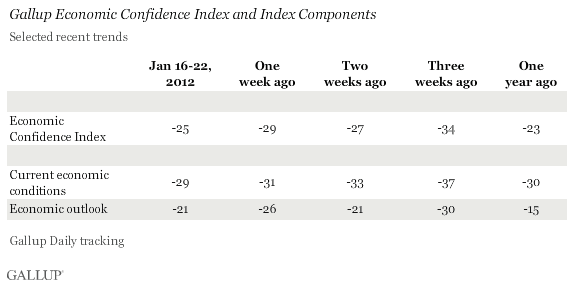PRINCETON, NJ -- U.S. economic confidence is at -25 in the week ending Jan. 22, improved from -29 the prior week and the best since the week ending May 22, 2011.

The Gallup Economic Confidence Index is an average of two components: Americans' ratings of current economic conditions and their outlook for the economy. Economic confidence is now not much different than the -23 for the same week a year ago and the -28 of the same week in 2010. Americans have grown steadily more positive about current economic conditions in the past three weeks. They are also now more positive about the future direction of the economy than they were three weeks ago, though these views have shown a less consistent pattern.

Americans' views of current economic conditions are about the same as what they were at the comparable time in the prior two years. Views on the economy's future direction are similar to those of the same week in 2010 but slightly less optimistic than in 2011. Consumer evaluations of the economic outlook have been much better during the comparable weeks in each of the past three years than they were in 2008 and 2009. The same is true for views of current conditions, with the exception of 2008, when consumers were more optimistic.

Bottom Line
U.S. economic confidence continues to improve, consistent with recent modest improvement in unemployment, positive news on jobless claims, and the general perception that the overall U.S. economy is getting slightly better. This seems like good news for the nation's businesses as well as for President Barack Obama's re-election chances as he presents his State of the Union message to the nation on Tuesday.
At the same time, U.S. gas prices have increased since late December and the European economy appears to be entering into a recession. In addition, this presidential election year is not only likely to produce a political stalemate but could lead to some political confrontations. So, current perceptions of the overall economic outlook could change in the weeks and months ahead.
In this regard, Americans are no more optimistic now than they were at this time in each of the past two years. In 2010 and 2011, perceptions of the economy waned as the year progressed. At this point, it is unclear whether that will also be the case in 2012.
Gallup.com reports results from these indexes in daily, weekly, and monthly averages and in Gallup.com stories. Complete trend data are always available to view and export in the following charts:
Daily: Employment, Economic Confidence and Job Creation, Consumer Spending
Weekly: Employment, Economic Confidence, Job Creation, Consumer Spending
Read more about Gallup's economic measures.
View our economic release schedule.
Survey Methods
Results are based on telephone interviews conducted weekly as part of Gallup Daily tracking with a random sample of more than 2,000 adults aged 18 and older, living in all 50 U.S. states and the District of Columbia, selected using random-digit-dial sampling.
For results based on the total sample of national adults, one can say with 95% confidence that the maximum margin of sampling error is ±3 percentage point.
Results for the week ending Jan. 22, 2012, are based on 3,491 telephone interviews conducted as part of Gallup Daily tracking with adults aged 18 and older, living in all 50 U.S. states and the District of Columbia, selected using random-digit-dial sampling. For results based on this weekly sample of national adults, one can say with 95% confidence that the maximum margin of sampling error is ±3 percentage point.
Interviews are conducted with respondents on landline telephones and cellular phones, with interviews conducted in Spanish for respondents who are primarily Spanish-speaking. Each sample includes a minimum quota of 400 cell phone respondents and 600 landline respondents per 1,000 national adults, with additional minimum quotas among landline respondents by region. Landline telephone numbers are chosen at random among listed telephone numbers. Cell phone numbers are selected using random-digit-dial methods. Landline respondents are chosen at random within each household on the basis of which member had the most recent birthday.
Samples are weighted by gender, age, race, Hispanic ethnicity, education, region, adults in the household, and phone status (cell phone only/landline only/both, cell phone mostly, and having an unlisted landline number). Demographic weighting targets are based on the March 2011 Current Population Survey figures for the aged 18 and older non-institutionalized population living in U.S. telephone households. All reported margins of sampling error include the computed design effects for weighting and sample design.
In addition to sampling error, question wording and practical difficulties in conducting surveys can introduce error or bias into the findings of public opinion polls.
For more details on Gallup's polling methodology, visit www.gallup.com.
